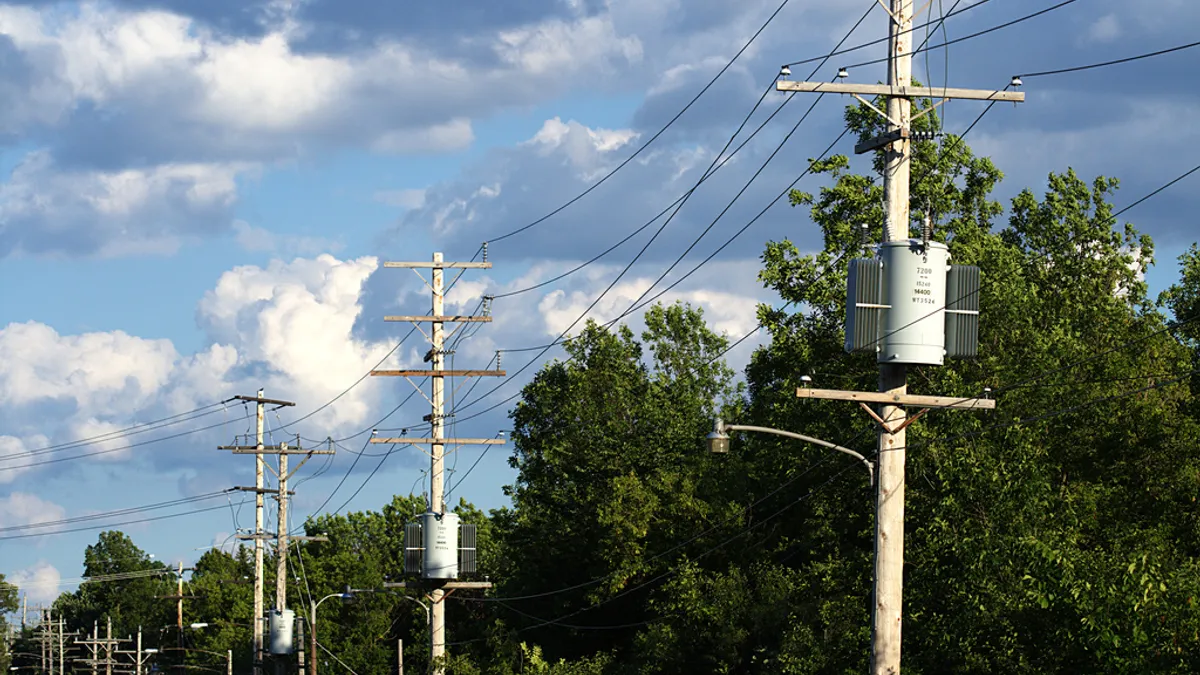Dive Brief:
- A shortage of distribution system transformers is depleting replacement equipment stockpiles and delaying or canceling some electrification projects, the electric utility sector warned federal lawmakers in a November letter. The industry’s ability to quickly restore power following storms is also at risk, they said.
- A group of lawmakers led by Rep. Sean Casten, D-Ill., is urging the government to authorize $2.1 billion in disaster supplemental funding to address the shortage of electrical transformers and complementary grid security technologies through the Defense Production Act.
- The delays are “ubiquitous, across the country,” Joy Ditto, president and CEO of the American Public Power Association, said in an interview. Procurement times for a new distribution level transformer have risen to more than a year, up from about about three months in 2020, and average costs have doubled or tripled, she said.
Dive Insight:
The shortage of distribution system transformers is a relatively new issue and is separate from a longer-standing shortage of large bulk power system transformers. Both, however, are a threat to grid security and are driving up costs, say experts.
The cost of large transformers is up 20% to 50% since 2020, said Grid Assurance CEO Dave Rupert. The company stockpiles bulk power system equipment for subscribers, or for sale to nonsubscribers. Time to procure equipment has grown to 20 to 39 months from 16 to 20 months a year ago, Rupert said.
“I think there's going to be more oversight and scrutiny on utilities, and I think the ratepayers are really concerned about the costs,” Rupert told Utility Dive.
“We’ve known for a while that large power transformer manufacturing has gone offshore,” Ditto said. “It’s a much more complex piece of equipment, much larger, much more difficult to transport,” and with varying cybersecurity concerns due to smart components.
The shortage of distribution-level transformers caught the utility industry by surprise, Ditto said.
“There had been a relatively robust manufacturing sector here, and because the lead times had for many, many years averaged about three months we had not focused as much on the need to shore up that supply chain piece,” Ditto said.
While the average price for distribition transformers may have doubled or tripled, Ditto also noted that outliers can be much higher. A small utility in Tennessee paying $2,400 for a transformer now faces a $24,000 bill, she said.
“Clearly, there's money flowing. But there's this supply-and-demand piece coming into play,” Ditto said.
Only a few domestic manufacturers of distribution system transformers operate, said Ditto, and reasons for the delays and shortages include constraints on labor, materials and production capacity. “All big deals,” she said.
APPA, along with the Edison Electric Institute, which represents investor-owned utilities, the National Rural Electric Cooperative Association and homebuilder groups, in a Nov. 18 letter urged House and Senate leadership to appropriate $1 billion this year “for implementation of the Defense Production Act to specifically address the supply chain crisis for electric distribution transformers.”
“Construction and electrification projects are now being deferred or canceled,” the groups said, and utilities “are concerned about their ability to adequately respond to major storms due to depleted stockpiles.”
The $2.1 billion considered in Casten’s letter is “an evolution of that ask,” Ditto said. “It’s obviously good news,” though “not over the hump yet.”
Casten’s letter, to the chairs and ranking members of the House and Senate appropriation committees, called for disaster supplemental funding “to expand domestic manufacturing of transformers and grid components, including electrical steels, flexible transformers, circuit breakers, switchgear or substation to serve load and interconnect generation and inverters and optimizers to integrate the influx of distributed generators.”
Addressing the transformer shortage is a key to grid reliability, storm recovery and meeting clean energy goals such as electrifying the country’s transportation system, Ditto said.
“We’ve seen some construction put on pause. You cannot electrify electric vehicle infrastructure without transformers,” she said. “It's so fundamental to everything.”















